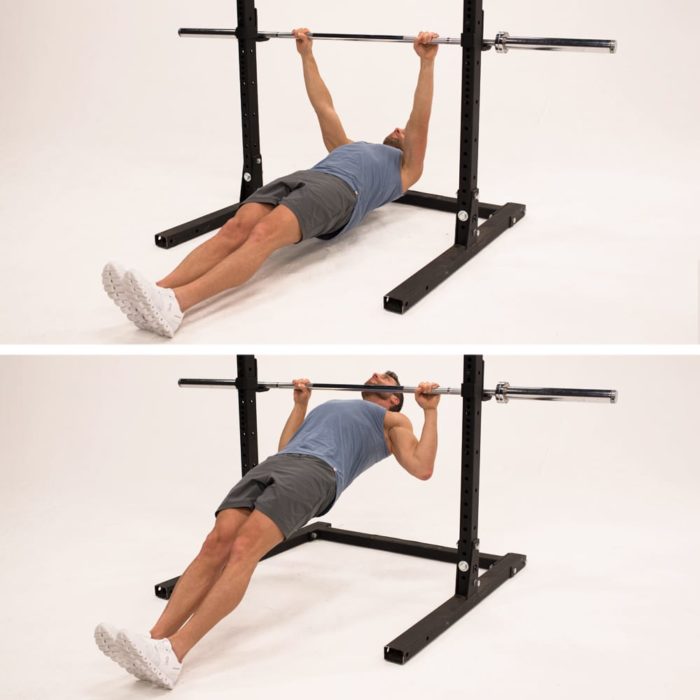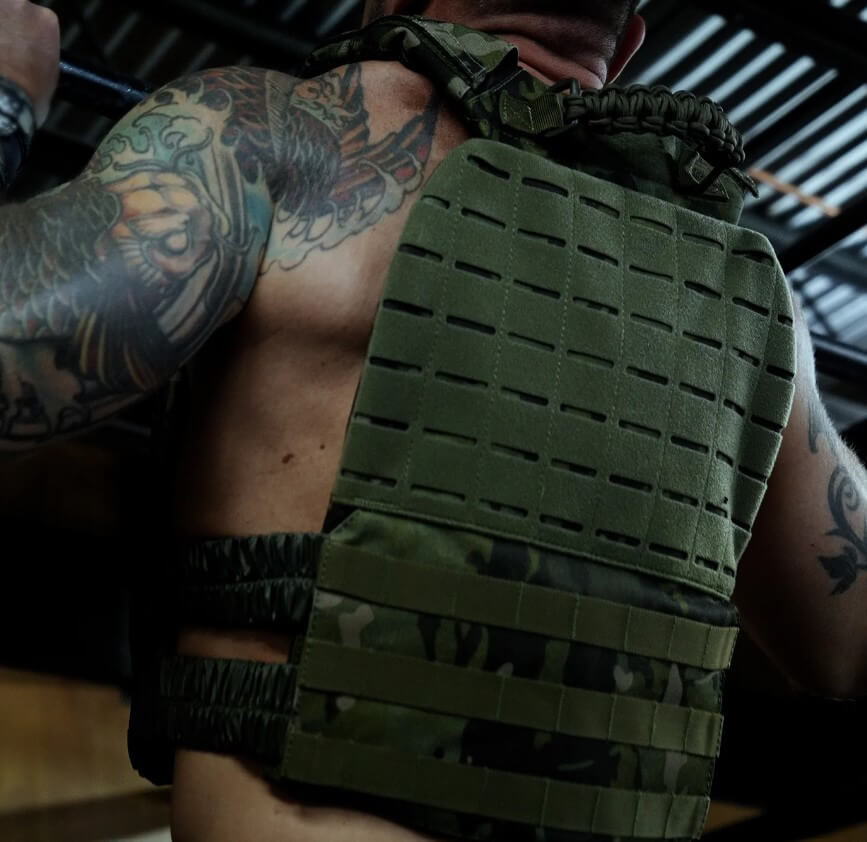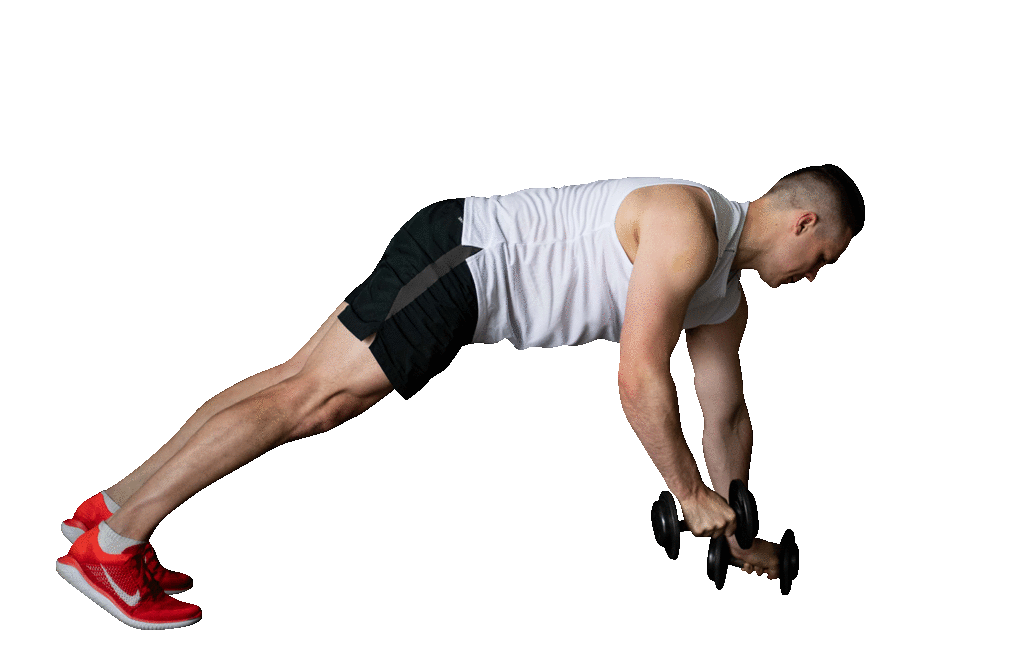Inverted rows, often referred to as Body rows or Australian pull-ups, stand as a testament to the effectiveness of bodyweight exercises in building strength and promoting overall fitness. Inverted rows exemplify the versatility of bodyweight exercises, seamlessly blending simplicity with effectiveness. Whether you're a seasoned fitness enthusiast or a beginner on the wellness journey, these rows offer a dynamic and accessible pathway to enhancing strength and holistic fitness. As we unravel the layers of technique, delve into the myriad benefits, and explore diverse variations, you'll gain not just a workout routine but a comprehensive understanding of how inverted rows can be a cornerstone in achieving a resilient and well-balanced physique. This guide aims to empower you with the knowledge to not only master the art of inverted rows but also integrate them seamlessly into your fitness repertoire, ensuring a transformative and fulfilling fitness experience.
Which Muscles are worked during Inverted Rows?
Inverted rows are a powerhouse exercise that engages various muscle groups, contributing to a sculpted upper body. Understanding the intricacies of each involved muscle provides insights into the comprehensive benefits of this dynamic movement.
Latissimus Dorsi
The latissimus dorsi, commonly known as the "lats," is the largest muscle in the back. It spans the lower and middle back, extending to the sides, and plays a pivotal role in the pulling motion during inverted rows.
The primary function of the lats is to bring the upper arms toward the body, a movement crucial for exercises like inverted rows. Strengthening the lats contributes to a broader and well-defined back, enhancing the overall aesthetic of the upper body.
Benefits: Developing the latissimus dorsi not only contributes to a visually appealing physique but also supports functional movements such as pulling, lifting, and maintaining posture.
Rhomboids
The rhomboids are situated between the shoulder blades and are responsible for scapular retraction, the squeezing together of the shoulder blades. This function is essential for maintaining healthy shoulder movement and promoting good posture.
During inverted rows, the rhomboids are actively engaged as they work to retract the shoulder blades. This action not only targets the upper back but also contributes to shoulder stability, reducing the risk of imbalances or injuries.
Benefits: Strengthening the rhomboids enhances posture, reduces the likelihood of rounded shoulders, and supports overall shoulder health
Trapezius
The trapezius, often referred to as the "traps," is a large, triangular muscle that extends down the spine and across the back of the neck and shoulders. It is divided into three parts: the upper, middle, and lower trapezius.
The trapezius is involved in various movements, including scapular elevation, depression, and retraction. During inverted rows, it provides crucial support to the shoulder muscles and aids in maintaining overall upper body strength and stability.
Benefits: Strengthening the trapezius contributes to a well-defined upper back and neck region. Additionally, a strong trapezius helps prevent shoulder injuries and supports proper movement patterns.
Biceps
The biceps brachii, commonly known as the biceps, are located on the front of the upper arm. While traditionally associated with arm flexion, the biceps also play a supportive role in various pulling exercises.
During inverted rows, the biceps are actively involved in the pulling motion, contributing to the flexion of the elbow. While not the primary focus of the exercise, the engagement of the biceps adds an extra dimension to arm strength.
Benefits: Developing the biceps through exercises like inverted rows provides comprehensive arm strength and aesthetics. Additionally, strong biceps contribute to the overall pulling power of the upper body.
Understanding the role of each muscle in inverted rows highlights the holistic benefits of this exercise. From building a well-defined back to supporting posture and shoulder health, inverted rows stand as a versatile and effective addition to any upper body workout routine.
Performing Inverted Rows at Home: A Step-by-Step Guide

Inverted rows at home are an excellent way to target your upper back, improve posture, and build strength using minimal equipment. Here's a straightforward guide to performing inverted rows in the comfort of your home:
1. Setup
- Find a sturdy horizontal bar at an appropriate height. This could be a pull-up bar, a sturdy table, or any fixed structure.
- Lie down beneath the bar, facing upward.
- Extend your arms and grasp the bar with an overhand grip, palms facing away from you. Ensure your hands are slightly wider than shoulder-width apart.
2. Body Position
- Keep your body in a straight line from head to heels. Engage your core to maintain a plank position.
- Place your feet flat on the ground, hip-width apart. Your knees should be bent at a comfortable angle.
3. Initiate the Movement
- Pull your chest towards the bar by bending your elbows. Focus on squeezing your shoulder blades together at the top of the movement.
- Keep your body straight throughout the motion, avoiding any sagging in the hips or bending at the waist.
4. Peak Contraction
- Once your chest reaches the bar, pause for a moment, and feel the contraction in your upper back muscles.
- Ensure a full range of motion by bringing your chest as close to the bar as possible without compromising form.
5. Controlled Descent
- Lower your body back down with control, fully extending your arms. Maintain a steady and controlled movement throughout the descent.
- Aim for a smooth transition between the upward and downward phases of the exercise.
6. Repetitions and Sets
- Start with a manageable number of repetitions, such as 8-12, depending on your fitness level.
- Perform multiple sets, allowing sufficient rest between each set. Adjust the number of sets based on your workout goals and intensity preference.
Inverted Rows with Dumbbells
Performing inverted rows with dumbbells adds an extra challenge to the exercise, engaging both arms independently. Here's a step-by-step guide on how to do inverted rows with dumbbells:
- Rest against a bench with a 45 degree incline. Your body should be straight, with your heels on the ground and your arms towards the floor. This will be your starting position.
- Begin by flexing the elbow, pulling the dumbbells towards you. Retract your shoulder blades as you perform the movement.
- Pull your chest towards the dumbbells by bending your elbows.
- Squeeze your shoulder blades together at the top of the movement.
- Pause briefly at the peak contraction.
- Lower your body back down with control, fully extending your arms.
- Maintain a steady and controlled movement throughout the descent.
Incorporate this variation into your routine for a challenging upper body workout with an emphasis on bilateral arm engagement and improved grip strength. Adjust the weight as needed, and enjoy the benefits of this effective and versatile exercise.
Benefits of Inverted Rows: A Comprehensive Overview
Upper Back Development
Inverted rows effectively target the latissimus dorsi, rhomboids, and traps, leading to a stronger and more defined upper back.
Improved upper back strength enhances posture, provides better shoulder stability, and contributes to an aesthetically pleasing physique.
Scapular Retraction
The pulling motion involved in inverted rows promotes scapular retraction, a vital movement for shoulder health.
Enhanced scapular retraction contributes to improved posture, reduced risk of shoulder impingements, and overall shoulder joint health.
Core Engagement
Maintaining a straight body line during inverted rows engages the core muscles.
The core stability developed through this exercise supports overall spine health, prevents lower back strain, and improves balance in various physical activities.
Joint-Friendly Exercise
Inverted rows are gentler on the shoulder joints compared to some other upper body exercises.
This makes inverted rows suitable for individuals with shoulder concerns, providing an effective upper body workout with reduced risk of discomfort or injury.
Versatility and Accessibility
Inverted rows can be adapted to various fitness levels by adjusting the angle or incorporating variations.
This versatility makes inverted rows accessible for beginners and allows for progressive intensification as individuals gain strength and proficiency.
Posture Improvement
The engagement of muscles like the rhomboids and traps supports proper posture by counteracting the effects of prolonged sitting and slouching.
Improved posture not only enhances appearance but also reduces the risk of musculoskeletal issues and contributes to overall well-being.
Improved Grip Strength
Gripping the bar or handles during inverted rows challenges and enhances grip strength.
Improved grip strength extends benefits beyond the exercise itself, supporting various daily activities and preventing issues related to weak hand strength.
Inverted Rows Variations
Feet-Elevated Inverted Rows
How to Do It
- Place a sturdy surface (bench, box, or step) below the bar.
- Lie on your back, grasp the bar, and lift your feet onto the elevated surface.
Benefits
- Increases difficulty, targeting upper back muscles at a different angle.
- Engages core and lower body for stability.
Wide Grip Inverted Rows
How to Do It
- Position your hands wider than shoulder-width on the bar.
- Perform inverted rows with the wider hand placement.
Benefits
- Targets the outer part of the upper back, emphasizing different muscle fibers.
- Adds variety to your workout routine.
Single-Leg Inverted Rows
How to Do It
- Lift one leg off the ground while maintaining a straight body line.
- Perform inverted rows with the elevated leg throughout the set.
Benefits
- Increases instability, engaging stabilizer muscles.
- Enhances balance and addresses unilateral strength imbalances.
Underhand Grip Inverted Rows
How to Do It
- Change your hand position to an underhand grip, palms facing you.
- Maintain the same body position and perform inverted rows.
Benefits
- Alters muscle engagement, emphasizing biceps and lower traps.
- Adds variety to your upper body workout.
Weighted Inverted Rows
How to Do It
- Hold a dumbbell or weight plate securely on your chest.
- Perform inverted rows with the additional resistance.
Benefits
- Increases resistance for advanced strength training.
- Allows for progressive overload, promoting muscle growth and strength.
Progression Guide
Here's a progression guide for inverted rows from beginner to intermediate and advanced levels:
Beginner Level
Standard Inverted Rows- Lie on your back under a bar or sturdy surface. Grasp the bar with an overhand grip and pull your chest towards the bar.
- Focus on mastering proper form, maintaining a straight body line, and initiating the movement from the upper back.
- Increase the number of repetitions per set (e.g., 12-15 reps).
- Build muscular endurance and adapt your body to the movement.
Intermediate Level
Feet-Elevated Inverted Rows- Place your feet on an elevated surface (bench or box) while performing inverted rows.
- Gradually increase the height of the surface to intensify the exercise.
- Widen your hand placement on the bar, beyond shoulder-width.
- Engage different muscle fibers in the upper back for added challenge.
- Lift one leg off the ground during each repetition.
- Tips: Introduce instability, requiring increased core engagement and balance.
Advanced Level
Underhand Grip Inverted Rows- Change your hand position to an underhand grip, palms facing you.
- Emphasize biceps and lower traps, providing a unique challenge.
- Hang two towels over the bar and grasp them with a neutral grip.
- Challenge grip strength and stability, targeting muscles differently.
- Hold a dumbbell or weight plate on your chest during inverted rows.
- Gradually increase the weight for progressive overload and increased resistance.
Always prioritise proper form, and progress at a pace that allows your body to adapt while minimising the risk of injury. Listen to your body, and consult with a fitness professional if needed.
Answering some FAQ’s about Inverted Rows
Q.How to do inverted rows without equipment?A: Find a sturdy horizontal bar at an appropriate height. Lie down beneath the bar, facing upward, and grasp the bar with an overhand grip. Keep your body in a straight line and pull your chest towards the bar.
Q.What angle is best for inverted rows?
A: A horizontal bar or surface is ideal for standard inverted rows. However, the angle can be adjusted based on your fitness level. Beginners may start with a higher bar, while advanced individuals can lower the bar to increase difficulty.
Q.Are inverted rows safe for shoulders?
A: Inverted rows are generally safe for shoulders when performed with proper form. They engage the upper back muscles without putting excessive stress on the shoulder joints. However, individuals with existing shoulder issues should consult a healthcare professional before attempting inverted rows.
Q.Do inverted rows help biceps?
A: Yes, inverted rows engage the biceps as secondary muscles. The pulling motion involved in the exercise activates the biceps, contributing to overall arm strength and development.
Q.Are inverted rows necessary?
A: While not strictly necessary, inverted rows are a valuable exercise for targeting the upper back, improving posture, and engaging various muscle groups. They offer a versatile and effective way to build strength using body weight or minimal equipment.
Q.Are inverted rows for beginners?
A: Yes, inverted rows can be adapted for beginners. Starting with a higher bar and gradually lowering it as strength improves allows beginners to build the necessary foundation. Beginners should focus on mastering proper form before progressing to more advanced variations.
Conclusion
Inverted rows, also known as body rows or Australian pull-ups, showcase the effectiveness of bodyweight exercises in sculpting a robust physique. This guide has delved into the intricacies of the inverted row technique, revealing the holistic benefits and diverse variations, providing expertise for optimal utilisation. Understanding the muscles engaged, mastering home workouts, incorporating dumbbells for added challenge, and progressing from beginner to expert levels—all contribute to a comprehensive approach to upper body strength.
As a cornerstone of fitness routines, inverted rows offer benefits ranging from upper back development and improved posture to joint-friendly attributes. The inclusion of FAQs addresses common concerns, ensuring individuals of all fitness levels can seamlessly integrate this dynamic exercise into their regimens. In mastering inverted rows, one not only unlocks the potential for a sculpted physique but also embraces a transformative journey toward resilience and overall well-being—a testament to the profound impact of bodyweight movements on the path to a healthier, stronger self.










